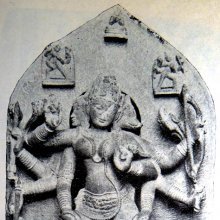Samkshipta, Saṃkṣipta: 8 definitions
Introduction:
Samkshipta means something in Buddhism, Pali, Hinduism, Sanskrit, Hindi. If you want to know the exact meaning, history, etymology or English translation of this term then check out the descriptions on this page. Add your comment or reference to a book if you want to contribute to this summary article.
The Sanskrit term Saṃkṣipta can be transliterated into English as Samksipta or Samkshipta, using the IAST transliteration scheme (?).
Alternative spellings of this word include Sankshipt.
Images (photo gallery)
In Hinduism
Jyotisha (astronomy and astrology)
Source: Wisdom Library: Brihat Samhita by VarahamihiraSaṃkṣipta (संक्षिप्त) refers to one of the seven “courses of Mercury” (Budhacāra), according to the Bṛhatsaṃhitā (chapter 7), an encyclopedic Sanskrit work written by Varāhamihira mainly focusing on the science of ancient Indian astronomy astronomy (Jyotiṣa).—Accordingly, “If Mercury should pass through the constellations of Puṣya, Punarvasu and the two Phālgunis, his course is known as Saṃkṣipta. [...] When Mercury is in his Prākṛta course, there will be increase of health, of rain, of crops and there will be prosperity in the land. If he should be either in his Saṃkṣipta or Miśra course, mankind will be partly happy and partly miserable. When in his remaining four courses, Mercury brings on adversity”.

Jyotisha (ज्योतिष, jyotiṣa or jyotish) refers to ‘astronomy’ or “Vedic astrology” and represents the fifth of the six Vedangas (additional sciences to be studied along with the Vedas). Jyotisha concerns itself with the study and prediction of the movements of celestial bodies, in order to calculate the auspicious time for rituals and ceremonies.
In Buddhism
Mahayana (major branch of Buddhism)
Source: Wisdom Library: Maha Prajnaparamita SastraSaṃkṣipta (संक्षिप्त) refers to “concentration” (i.e., that which is ‘concentrated together’ [?]), according to Mahāprajñāpāramitāśāstra (chapter 31).—Accordingly, “Although the mind is included in the inner bases of consciousness, when it takes as object an outer dharma, it is outer mind, and when it takes as object an inner dharma, it is inner mind. The mental consciousness (manovijñāna) is an inner mind, and the [first] five consciousnesses (pañcavijñāna) are outer minds. The concentrated mind (saṃkṣipta-citta) that penetrates into meditation (dhyānapraviṣṭa) is an inner mind; the distracted mind (vikṣiptacitta) is an outer mind. [...]”.

Mahayana (महायान, mahāyāna) is a major branch of Buddhism focusing on the path of a Bodhisattva (spiritual aspirants/ enlightened beings). Extant literature is vast and primarely composed in the Sanskrit language. There are many sūtras of which some of the earliest are the various Prajñāpāramitā sūtras.
Languages of India and abroad
Sanskrit dictionary
Source: DDSA: The practical Sanskrit-English dictionarySaṃkṣipta (संक्षिप्त).—p. p.
1) Heaped together.
2) Compressed, contracted; एकप्रकारसंक्षिप्तं कोसलराज्यम् (ekaprakārasaṃkṣiptaṃ kosalarājyam) Pratimā 1; एकशरीर- संक्षिप्ता पृथिवी रक्षितव्या (ekaśarīra- saṃkṣiptā pṛthivī rakṣitavyā).
3) Abridged, curtailed, shortened.
4) Diminished, lessened.
5) Brief, concise, short.
6) Restrained.
7) Thrown, despatched
8) Seized; grasped.
Source: Cologne Digital Sanskrit Dictionaries: Cappeller Sanskrit-English DictionarySaṃkṣipta (संक्षिप्त).—[adjective] thrown together, compressed, narrow, small, short; abridged, concise.
Source: Cologne Digital Sanskrit Dictionaries: Monier-Williams Sanskrit-English Dictionary1) Saṃkṣipta (संक्षिप्त):—[=saṃ-kṣipta] [from saṃ-kṣip] mfn. thrown or dashed or heaped together etc.
2) [v.s. ...] abbreviated, contracted, condensed, [Mahābhārata; Sāṃkhyakārikā] (tena ind. ‘concisely’ [Divyāvadāna])
3) [v.s. ...] narrow, short, small, [Nirukta, by Yāska; Mālavikāgnimitra; Suśruta]
4) [v.s. ...] taken from or away, seized, [Horace H. Wilson]
5) Saṃkṣiptā (संक्षिप्ता):—[=saṃ-kṣiptā] [from saṃ-kṣipta > saṃ-kṣip] f. = -gati, [Varāha-mihira’s Bṛhat-saṃhitā]
Source: DDSA: Paia-sadda-mahannavo; a comprehensive Prakrit Hindi dictionary (S)Saṃkṣipta (संक्षिप्त) in the Sanskrit language is related to the Prakrit word: Saṃkhitta.
[Sanskrit to German]
Sanskrit, also spelled संस्कृतम् (saṃskṛtam), is an ancient language of India commonly seen as the grandmother of the Indo-European language family (even English!). Closely allied with Prakrit and Pali, Sanskrit is more exhaustive in both grammar and terms and has the most extensive collection of literature in the world, greatly surpassing its sister-languages Greek and Latin.
Hindi dictionary
Source: DDSA: A practical Hindi-English dictionarySaṃkṣipta (संक्षिप्त) [Also spelled sankshipt]:—(a) brief, short, summary; abridged; —[ṭippaṇī] a brief note; ~[tā] brevity; abridgement; —[saṃskaraṇa] abridged edition.
...
See also (Relevant definitions)
Partial matches: Kshipta, Sam.
Starts with (+13): Samkshipta-giti-kavita, Samkshipta-lipi, Samkshipta-rupama, Samkshiptabharata, Samkshiptabhashya, Samkshiptabhishekavidhi, Samkshiptabuddhi, Samkshiptacalarcavidhi, Samkshiptacitta, Samkshiptadairghya, Samkshiptagati, Samkshiptahnikapaddhati, Samkshiptahomaprakara, Samkshiptaka, Samkshiptakadambari, Samkshiptamarici, Samkshiptanirnayasindhu, Samkshiptaraganuga pujapaddhati, Samkshiptaraganugapujapaddhati, Samkshiptaramayanapathaprayoga.
Ends with: Abhisamkshipta, Asamkshipta, Sankshipta, Vedantasutravrittih samkshipta, Vedantasutravrittisamkshipta.
Full-text (+218): Samkshiptatva, Samkshiptavedantashastraprakriya, Samkshiptaka, Samkshiptavedanta, Samkshiptabhashya, Samkshiptashyamapujapaddhati, Samkshiptakadambari, Samkshiptashastrarthapaddhati, Samkshiptaraganugapujapaddhati, Sankshipt, Samkshiptanirnayasindhu, Samkshiptasarasamgraha, Samkshiptaramayanapathaprayoga, Samkshiptahomaprakara, Samkshiptadairghya, Samkshiptabharata, Samkshiptacalarcavidhi, Samkshiptasara, Samkshiptagati, Samkshiptena.
Relevant text
Search found 7 books and stories containing Samkshipta, Saṃkṣipta, Samksipta, Sam-kshipta, Saṃ-kṣipta, Sam-ksipta, Saṃkṣiptā, Saṃ-kṣiptā; (plurals include: Samkshiptas, Saṃkṣiptas, Samksiptas, kshiptas, kṣiptas, ksiptas, Saṃkṣiptās, kṣiptās). You can also click to the full overview containing English textual excerpts. Below are direct links for the most relevant articles:
Brihat Samhita (by N. Chidambaram Iyer)
The Tattvasangraha [with commentary] (by Ganganatha Jha)
Verse 2410-2411 < [Chapter 24b - Arguments against the reliability of the Veda (the Revealed Word)]
Satirical works of Kshemendra (study) (by Arpana Devi)
9. Friends and Disciples < [Chapter 2 - Kṣemendra: His Life and Works]
The Indian Buddhist Iconography (by Benoytosh Bhattachacharyya)
Maha Prajnaparamita Sastra (by Gelongma Karma Migme Chödrön)
II.7. Other qualities of the Buddhist Dharma < [II. Recollection of the Dharma (dharmānusmṛti)]
Sushruta Samhita, volume 1: Sutrasthana (by Kaviraj Kunja Lal Bhishagratna)



